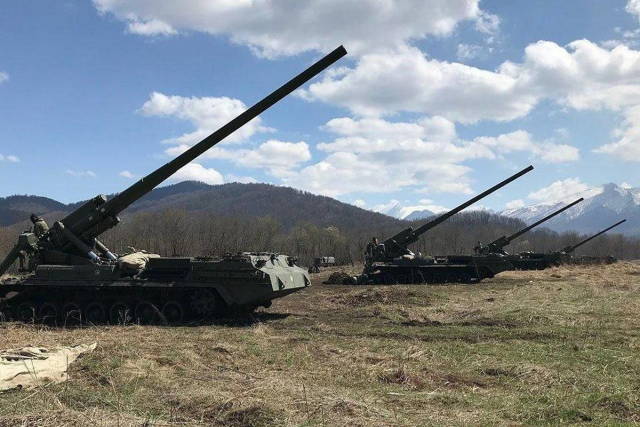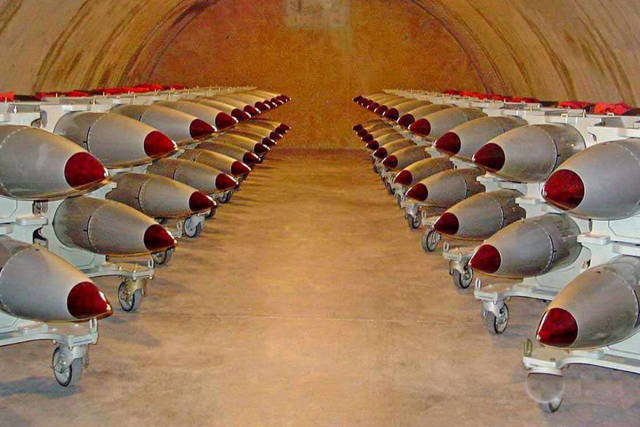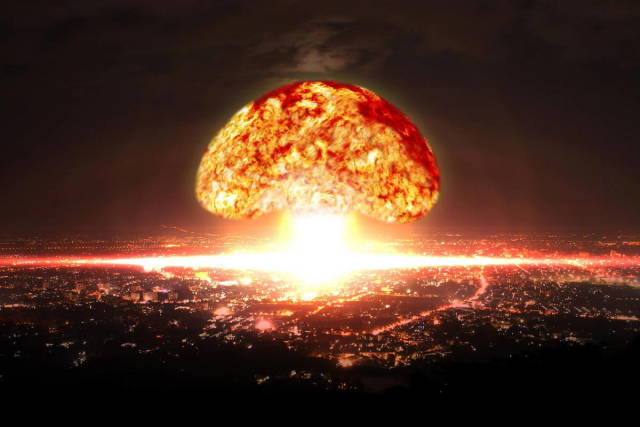We continue to monitor the assessments of foreign (mainly Western) military analysts of Russia's special operation in Ukraine. The ratings of the first two articles (read here and here ) indicate a lively interest in the events taking place. In this article, readers are invited to the next publication of the Institute of Modern Warfare entitled "Would Russia USE TACTICAL nuclear weapons in Ukraine?" (WOULD RUSSIA USE A TACTICAL NUCLEAR WEAPON IN UKRAINE?).

Al Mauroni
The author is Al Mauroni, director of the Center for Strategic Deterrence Studies of the US Air Force (US Air Force Center for Strategic Deterrence Studies) and author of the book "Countering Weapons of Mass Destruction: Assessing the policy of the US government" (Countering Weapons of Mass Destruction: Assessing the U.S. Government's Policy).
In this case, I would like to emphasize that the translation is made with the preservation of the author's style! Under the heading "Foreign author", the editorial board of IVi tries to represent a wide range of views of foreign military specialists. At the same time, it should be noted that the adequacy of some theories considered abroad raises many questions.
The recent saber rattling by Russian President Vladimir Putin forces the West to face a question that even many national security experts could ignore for decades: will Putin really use tactical nuclear weapons? More precisely, would he have ordered a tactical nuclear strike on the Ukrainian armed forces out of frustration that his armed forces had not achieved their goals? Assessing this possibility requires a reassessment of some assumptions, which is long overdue.
Russian nuclear weapons in the context of
In the current circumstances, Putin could consider the use of nuclear weapons as a necessary condition to ensure that Russia's national security interests are not undermined by the West's open military support for Ukraine's efforts, which would be consistent with the declared Russian doctrine. One of the options could be a so-called demonstration strike with a single low-power nuclear explosion in Ukraine or over the Black Sea, which would serve as a dramatic warning that resistance to the Russian military campaign should be stopped, backed up by a convincing threat of further tactical nuclear strikes. There is no doubt that Putin has already signaled the possible use of nuclear weapons and stated his (alleged) concern about the deployment of nuclear weapons in Ukraine for use against Russia.
Apart from the question of whether a Russian nuclear strike is credible as an aspect of future military operations in Ukraine, there are many reasons why a reasonable policy should consider the threat of Russia using nuclear weapons as plausible. Firstly, Russia does not have a policy of "non-use first" and has a doctrine of the use of nuclear weapons in the event of a loss of a conventional conflict with NATO forces. A nuclear attack on Ukraine will be aimed at allowing Russia to end the regional conflict on terms acceptable to its leadership. Secondly, Russia under Putin invested heavily in the modernization of nuclear weapons and often conducted exercises of its nuclear forces. Thirdly, Putin expressed concern about Ukraine's development of a nuclear "dirty bomb", as well as "aggressive statements" by NATO powers. These false statements could have been intended to create a pretext for a war with the use of tactical nuclear weapons. On the other hand, it may simply be balancing on the brink of a nuclear war, which will not play in favor of Russia.

Russian high-power self-propelled gun 2S7M "Malka"
Indeed, the Russian Federation joined the other four States designated in the Treaty on the Non-Proliferation of Nuclear Weapons as "nuclear-weapon States" in a joint statement stating that "a nuclear war cannot be won and can never be waged." However, it is important to clarify that this statement is not a general call for disarmament or a guarantee that nuclear weapons will never be used. It reflects the view of the five nuclear-weapon States that their retention of nuclear weapons serves as a basis for preventing a nuclear war between nuclear States, and not a moral condemnation of such a war. Russia has almost two thousand tactical nuclear weapons, and it continues to modernize this potential, possibly as a measure aimed at increasing its (defiantly insufficient) armed forces as more advanced modern conventional ammunition is developed. It is clear that Putin has defined the role of nuclear weapons in his worldview, and at the same time Western politicians and strategists have not used the possibility of using nuclear weapons in modern conflicts.
Erroneous assumptions
The Russian invasion of Ukraine caused a flurry of comments from nuclear weapons experts on Twitter regarding the consequences of a possible nuclear strike. These views are valuable and worth reading to understand the dynamics of deterrence in this scenario. At the same time, there are general national security analysts who are fixated on a number of hypotheses based on ideas from the Cold War. Among them, it should be noted: tactical nuclear weapons do not exist, since all nuclear weapons are strategic: any use of non-strategic nuclear weapons will inevitably lead to a full-scale nuclear war; and that Putin must be crazy if he thinks he can use nuclear weapons in Ukraine and not face nuclear retaliation.
Let's take them one at a time. The first assumption that tactical nuclear weapons do not exist is simply wrong and is based more on emotional experiences than on rational assessments. It depends on how we define the concepts of "tactical" and "strategic", and implicitly assumes that the detonation of any nuclear munition, regardless of power, will have a strategic effect. And, of course, any event related to nuclear weapons would have a strategic political effect spreading to the entire international community. But strategic effects come not only from strategic weapons. There is a difference between nuclear weapons delivered by strategic forces (missiles, bombers and submarines) against the critical infrastructure of the country, and nuclear weapons delivered by operational military units in the theater of operations against the enemy's armed forces.
We know that there are non-strategic nuclear weapons because the US and Russian governments clearly define some of the weapons and forces as strategic nuclear forces — land-based missiles with a range of more than 5,500 kilometers, modern submarine-launched ballistic missiles and heavy bombers. Anything not defined in this way falls under "non-strategic nuclear forces." Further, the Russian Federation defines tactical nuclear weapons as weapons "designed to destroy objects located in the tactical depth of the enemy's orders (up to 300 km), in order to solve a tactical task." We can call it a non-strategic weapon, a theater of operations weapon, or a tactical weapon, but everything turns out the same.
The US military has been arguing about the usefulness of tactical nuclear weapons since the beginning of the Cold War, and the debate continues today. In the report "Nuclear Posture Review 2018" (Nuclear Posture Review 2018), the requirement for low-power nuclear weapons was called a deterrent against the use of tactical nuclear weapons by Russia. The US Air Force is developing the concept of "conventional-nuclear integration", which calls on theater forces to consider the possibility of launching limited nuclear strikes during conventional combat operations against an enemy with nuclear potential. In recent testimony to the Senate Armed Services Committee, Admiral Charles Richard, commander of the US Strategic Command, noted that his command has been "preparing ... for many years together with other combat commands" for scenarios that included "limited use of nuclear weapons in a scenario of conventional aggression." He noted: "There is a significant class of threats in the theater that we will have to potentially rethink about how we can contain them." One of the starting points is the recognition that tactical nuclear weapons pose a threat to US superiority in conventional weapons, which cannot be contained by a conventional instrument of strategic nuclear forces.
The second assumption, that any use of tactical nuclear weapons will inevitably lead to an exchange of strategic nuclear strikes between Russia and the United States, is a hypothetical relic of the Cold War. Escalation models explore the process by which two equal competitors move from conventional to nuclear warfare during a direct conflict. Can a nuclear-weapon State dictate the pace of a crisis with another nuclear-weapon State and anticipate the reaction of its opponent, while avoiding strategic exchange in an all-out war? This is a theoretical construct that has not been tested. The Russian concept of strategic deterrence focuses on "escalation management", which uses both military and non-military measures to shape the decisions of the enemy. This concept differs from the American theory of strategic deterrence, which relies on "calculated ambiguity" to cause the enemy to doubt about the future actions of the United States.
A Russian nuclear attack on Ukraine will not be directed directly against US or NATO forces, although it will certainly be a direct signal to countries supporting the Ukrainian conflict. Consider a scenario in which Russia detonates a low-power (for example, less than five kilotons) nuclear device in the air over a Ukrainian mechanized brigade outside Kiev. As a result, it is possible to avoid the long-term consequences of precipitation. Since Ukraine is not a member of NATO, there is no way to immediately strike back at NATO. The US government has no extended promises of deterrence to the Ukrainian government. Will this unique event lead to the exchange of strategic nuclear strikes? Would the United States exchange New York for Kiev, to paraphrase General Charles de Gaulle? The Obama and Trump administrations took different approaches to the exercises with a limited nuclear strike by Russia. At the very least, there will be serious consequences, which may include an increased US military presence in Europe, additional flights of US strategic bombers to Europe, as well as new diplomatic and economic sanctions against Russia. But it is difficult to understand how a limited nuclear strike on Ukraine leads to a scenario of total war.

Tactical nuclear weapons of the US Army
The third assumption concerns Putin's rationality and the question of whether he will use tactical nuclear weapons, violating the international taboo on their use. In particular, one can question Putin's rationality in light of his surprising statements that Ukraine is developing a program to create weapons of mass destruction, that its government is run by fascists and that it is carrying out genocide against ethnic Russians in the Donbas. This view of his public statements overlooks the rational actor theory regarding state decisions related to nuclear weapons. A rational decision-maker studies the available information and makes a decision based on which course of action provides the greatest benefit, ideally at a lower cost than other options.
If Putin is a rational player, can he still consider a limited nuclear strike as part of his plans? He may believe that this is a rational act if he sees some benefit in achieving the goals of overcoming Ukrainian resistance, keeping NATO out of the conflict and, ultimately, restoring Russia's former glory. But he still has time to think about other options — cutting off electricity, food and medicine to Ukrainian cities, intensifying attacks on civilian infrastructure, or simply continuing to use his usual superiority over Ukrainian troops (despite the current setbacks). If the usual options do not work, he may resort to tactical nuclear weapons as a way to achieve his political goals. So yes, a rational actor could think about using nuclear weapons against a non-nuclear enemy.
We need to talk about tactical nuclear weapons
Given this information, it remains unclear whether Putin can order a limited nuclear attack – for example, a single explosion of a low-power warhead. But if he did, would the US be ready to respond? Admiral Richard's recent testimony before Congress suggests that the U.S. Strategic Command has had enough time to consider this scenario, and it has a plan. Of course, the politicians have the last word on military operations. In the absence of a direct strike against NATO, it is unlikely that the US military will be called upon to respond with a proportional response to Russian forces. Rather, diplomatic action will prevail, as the US will consult with its allies to determine what the next step will be. This could be an escalation; it's hard to say what will happen next because there is no modern precedent for a nation using tactical nuclear weapons. The US National Security community has not openly discussed or discussed what happens after the first nuclear bomb is used. We've been thinking about something else for the last twenty years.
Russia and China are considering the possibility of practical use of these weapons in the context of regional conflicts. As a result, we must accept the possibility of using tactical nuclear weapons. Perhaps it is foolish to discuss the military conflict with China and Russia, which remains at the usual level. We need to make the transition from conventional nuclear technologies and establish coordination processes between the geographic combat commands and the US Strategic Command, as well as with our allies. Within the Government, the national security community is hampered by an excessive classification of security on nuclear weapons issues. While the Defense Department's nuclear community can outline scenarios and develop plans, most politicians and military staffs do not engage in open discussions about U.S. nuclear capabilities or how we can respond to a limited nuclear war. It's not "thinking the unthinkable" to steal a line from Herman Kahn. I am not promoting the idea of participating in a limited nuclear war with Russia as a result of its actions in Ukraine. However, we need to better understand the possibility of the enemy using such weapons and discard the erroneous assumptions that currently exist in order to prepare for such a future and protect ourselves from it. Tactical nuclear weapons pose a threat to the United States and its allied relations. We need to sort this out.
According to the materials of the resource mwi.usma.edu
The materials of the article contain exclusively the author's estimates and do not reflect the position of the editorial board of IVi

